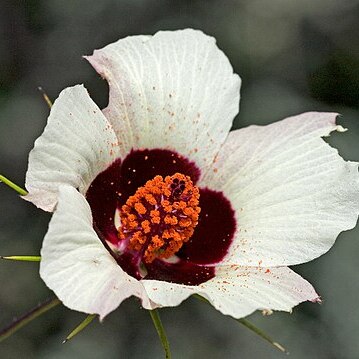Leaf digitately 3–5-foliolate or palmatisect; leaflets 2–10 × 1–3 cm., with sparse 2–3-pronged hairs mainly on the lower surface, apex acute, margin serrate, base cuneate; petiole up to 8 cm. long, pilose or setose-pilose; stipules 10–12 mm. long, linear to filiform.
Flowers up to 10 cm. in diam., yellow or cream with purple or reddish-brown centre, solitary, axillary; peduncle up to 12 cm. long, sparsely setose, articulated near the apex.
Calyx up to 3 cm. long; lobes up to 3 × 1 cm., ovate-lanceolate, acute to acuminate, 3–5-nerved, free almost to the base, sparsely pubescent on the margins.
Shrub, up to 2 m high. Epicalyx bracts 7-9, rigid and pungent. Seeds glabrescent. Flowers yellow or cream with purple or reddish brown centre.
Style projecting 1·5 mm. above the apex of the staminal tube before branching; branches 2 mm. long.
Seeds 5 × 3·5 mm., lune-shaped, very minutely scaly, with a few scattered hairs, ± glabrescent.
Epicalyx of 7–9 bracts; bracts 1·5–3·5 cm. long, stiff, pungent, slightly joined at the base.
Shrub up to 2 m. tall, sometimes subscandent; stems glabrous or sparsely setose.
Petals up to 5 × 4 cm., obovate, very sparsely setose or glabrous.
Staminal tube 15 mm. long; free parts of filaments 1·5–2 mm. long.
Capsule c. 15 × 13 mm., ovoid, sparsely setose.

